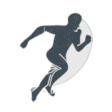Bankart Repair Rehabilitation Protocol
The intent of this protocol is to provide guidelines for the post-operative rehabilitation course after arthroscopic Bankart Repair Surgery. This protocol is based on a review of the best available scientific studies regarding shoulder rehabilitation. It is by no means intended to serve as a substitute for clinical decision making regarding the progression of a patient’s post-operative course. It should serve as a guideline based on the individual’s physical exam/findings, progress to date, and the absence of post- operative complications. If the physical therapist requires assistance in the progression of a post-operative patient they should consult with Dr. Johnson.
Phase I – Immediate Post Surgical (Weeks 1-4):
Goals: Maintain / protect integrity of repair
Gradually increase passive range of motion (PROM)
Diminish pain and inflammation
Prevent muscular inhibition
Become independent with activities of daily living with modifications
Precautions:
Maintain arm in abduction sling / brace, remove only for exercise
- No active range of motion (AROM) of shoulder
- No abduction and external rotation
- No lifting of objects
- No shoulder motion behind back
- No excessive stretching or sudden movements
- No supporting of any weight
- No lifting of body weight by hands
Keep incision clean and dry
Criteria for progression to the next phase (II):
- Passive forward flexion to at least 125 degrees
- Passive external rotation (ER) in scapular plane to at least 75 degrees
- Passive internal rotation (IR) in scapular plane to at least 75 degrees
- Passive Abduction to at least 90 degrees in the scapular plane
Week 1:
Abduction brace/sling
Pendulum exercises
Finger, wrist, and elbow AROM
Begin scapula musculature isometrics / sets; cervical ROM
Cryotherapy for pain and inflammation
-Day 1-2: as much as possible (20 minutes of every hour)
-Day 3-6: post activity, or for pain
Sleeping in abduction sling
Patient Education: posture, joint protection, positioning, hygiene, etc.
Week 2-4:
Continue use of abduction sling / brace
Pendulum exercises
Begin passive ROM to tolerance (these should be done supine and should be pain free)
– Flexion to 90 degrees
– ER to 20 degrees only with the arm at the side – IR to body/chest
Continue Elbow, wrist, and finger AROM / resisted
Cryotherapy as needed for pain control and inflammation
May resume general conditioning program – walking, stationary bicycle, etc.
Aquatherapy / pool therapy may begin (if available) at 3 weeks postop
Phase II – Protection / Active motion (weeks 4 – 6):
Goals: Allow healing of soft tissue
Do not overstress healing tissue
Gradually restore full passive ROM (week 4-6)
Decrease pain and inflammation
Precautions:
- No lifting
- No supporting of body weight by hands and arms
- No sudden jerking motions
- No excessive behind the back movements
- Avoid upper extremity bike or upper extremity ergometer at all times.
Criteria for progression to the next phase (III):
- Full active range of motion
WEEK 4-6:
Continue use of sling/brace full time until end of week 4
Between weeks 4 and 6 may use sling/brace for comfort only
Discontinue sling/ brace at end of week 6
Initiate active assisted range of motion (AAROM) flexion in supine position
Progressive passive ROM until approximately full ROM at Week 4-6.
Gentle Scapular/glenohumeral joint mobilization as indicated to regain full passive ROM
Initiate prone rowing to neutral arm position
Continue cryotherapy as needed
May use heat prior to ROM exercises
May use pool (aquatherapy) for light active ROM exercises
Ice after exercise
Phase III – Early strengthening (weeks 6-12):
Goals: Full active ROM (week 10-12)
Maintain full passive ROM
Dynamic shoulder stability
Gradual restoration of shoulder strength, power, and endurance Optimize neuromuscular control
Gradual return to functional activities
Precautions:
- No heavy lifting of objects (no heavier than 5 lbs.)
- No sudden lifting or pushing activities
- No sudden jerking motions
No overhead lifting
Criteria for progression to the next phase (IV):
- Able to tolerate the progression to low-level functional activities
- Demonstrates return of strength/dynamic shoulder stability
- Re-establish dynamic shoulder stability
- Demonstrates adequate strength and dynamic stability for progression to higher demanding work/sport specific activities.
WEEK 6 – 12:
Continue stretching and passive ROM (as needed)
Dynamic stabilization exercises
Initiate strengthening program
External rotation (ER)/Internal rotation (IR) with therabands/sport cord/tubing
- ER side-lying (lateral decubitus)Lateral raises*
- Full can in scapular plane* (avoid empty can abduction exercises at all times)
- Prone rowing
- Prone horizontal abduction
- Prone extension
- Elbow flexion
- Elbow extension
*Patient must be able to elevate arm without shoulder or scapular hiking before initiating isotonics; if unable, continue glenohumeral joint exercises
WEEK 12:
Continue all exercise listed above
Initiate light functional activities as Dr. Johnson suggests
Phase IV – Advanced strengthening (12 weeks to 6 months):
Goals: Maintain full non-painful active ROM
Advance conditioning exercises for enhanced functional use Improve muscular strength, power, and endurance
Gradual return to full functional activities
WEEK 16 – 20:
Continue ROM and self-capsular stretching for ROM maintenance
Continue progression of strengthening
Advance proprioceptive, neuromuscular activities
Light sports (golf chipping/putting, tennis ground strokes), if doing well
WEEK 20 – 24:
Continue strengthening and stretching
Continue stretching, if motion is tight
May initiate interval sport program (i.e. golf, doubles tennis, etc.), if appropriate
